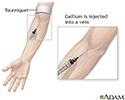Lung gallium scan
Gallium 67 lung scan; Lung scan; Gallium scan - lung; Scan - lungLung gallium scan is a type of nuclear scan that uses radioactive gallium to identify inflammation in the lungs.
Nuclear scan
A positron emission tomography (PET) scan is a type of imaging test. It uses a radioactive substance called a tracer to look for disease in the body...
How the Test is Performed
Gallium is injected into a vein. The scan will be taken 6 to 24 hours after the gallium is injected. (Test timing depends on whether your condition is acute or chronic.)
Acute
Acute means sudden. Acute symptoms appear, change, or worsen rapidly. It is the opposite of chronic.

Chronic
Chronic refers to something that continues over an extended period of time. A chronic condition is usually long-lasting and does not easily or quick...

During the test, you lie on a table that moves underneath a scanner called a gamma camera. The camera detects the radiation produced by the gallium. Images are displayed on a computer screen.
During the scan, it is important that you keep still to get a clear image. The technician can help make you comfortable before the scan begins. The test takes about 30 to 60 minutes.
How to Prepare for the Test
Several hours to 1 day before the scan, you will get an injection of gallium at the place where the testing will be done.
Just before the scan, remove jewelry, dentures, or other metal objects that can affect the scan. Take off the clothing on the upper half of your body and put on a hospital gown.
How the Test will Feel
The injection of gallium will sting, and the puncture site may hurt for several hours or days when touched.
The scan is painless, but you must stay still. This may cause discomfort for some people.
Why the Test is Performed
This test is usually done when you have signs of inflammation in the lungs. This is most often due to sarcoidosis or a certain type of pneumonia. It is not performed very often in recent years.
Sarcoidosis
Sarcoidosis is a disease in which inflammation occurs in the lymph nodes, lungs, liver, eyes, skin, and/or other tissues.

Normal Results
The lungs should appear of normal size and texture, and should take up very little gallium.
What Abnormal Results Mean
If a large amount of gallium is seen in the lungs, it may mean any of the following problems:
- Sarcoidosis (a disease in which inflammation occurs in the lungs and other tissues of the body)
- Other respiratory infections, most often a type of pneumonia caused by the fungus Pneumocystis jirovecii
Pneumocystis jirovecii
Pneumocystis jirovecii pneumonia is a fungal infection of the lungs. The disease used to be called Pneumocystis carinii or PCP pneumonia.
 ImageRead Article Now Book Mark Article
ImageRead Article Now Book Mark Article
Risks
There is some risk to children or unborn babies. Because a pregnant or nursing woman may pass on radiation, special precautions need to be taken.
For women who are not pregnant or nursing and for men, there is very little risk from the radiation in gallium, because the amount is very small. There are increased risks if you are exposed to radiation (such as x-rays and scans) many times. Discuss any concerns you have about radiation with your health care provider who recommends the test.
x-rays
X-rays are a type of electromagnetic radiation, just like visible light. An x-ray machine sends individual x-ray waves through the body. The images...

Considerations
Usually your provider will recommend this scan based on the results of a chest x-ray. Small defects may not be visible on the scan. For this reason, this test is not often done anymore.
Chest x-ray
A chest x-ray is an x-ray of the chest, lungs, heart, large arteries, ribs, and diaphragm.

References
Harisinghani MG, Chen JW, Weissleder R. Chest imaging. In: Harisinghani MG, Chen JW, Weissleder R, eds. Primer of Diagnostic Imaging. 6th ed. Philadelphia, PA: Elsevier; 2019:chap 1.
Jokerst CE, Gotway MB. Thoracic radiology: noninvasive diagnostic imaging. In: Broaddus VC, Ernst JD, King TE, et al, eds. Murray and Nadel's Textbook of Respiratory Medicine. 7th ed. Philadelphia, PA: Elsevier; 2022:chap 20.
-
Gallium injection - illustration
The gallium scan is a type of nuclear scan involving radioactive gallium which helps determine whether a patient has inflammation in the lungs. Gallium is injected in a vein and a series of x-rays are taken to identify where the gallium has accumulated in the lungs. This test is most often performed when there is evidence of inflammation in the lungs (sarcoidosis).
Gallium injection
illustration
-
Gallium injection - illustration
The gallium scan is a type of nuclear scan involving radioactive gallium which helps determine whether a patient has inflammation in the lungs. Gallium is injected in a vein and a series of x-rays are taken to identify where the gallium has accumulated in the lungs. This test is most often performed when there is evidence of inflammation in the lungs (sarcoidosis).
Gallium injection
illustration
Review Date: 8/19/2024
Reviewed By: Allen J. Blaivas, DO, Division of Pulmonary, Critical Care, and Sleep Medicine, VA New Jersey Health Care System, Clinical Assistant Professor, Rutgers New Jersey Medical School, East Orange, NJ. Review provided by VeriMed Healthcare Network. Also reviewed by David C. Dugdale, MD, Medical Director, Brenda Conaway, Editorial Director, and the A.D.A.M. Editorial team.


